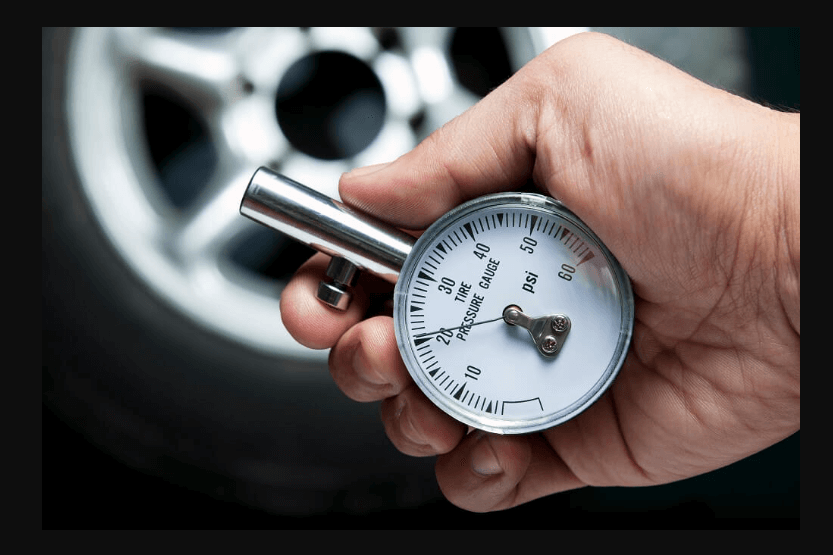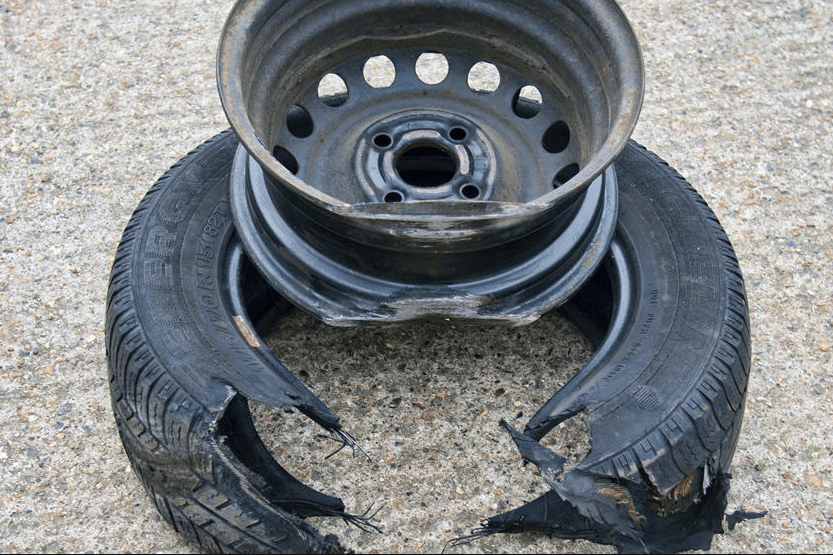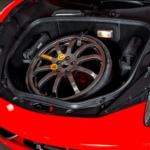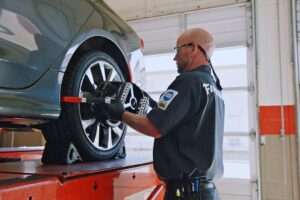When a driver experiences a flat tire or blowout, they may need to rely on their spare tire to get them to a safe location or to a repair shop.
However, many drivers may not realize that their spare tire has a higher PSI (pounds per square inch) than their regular tires. But why is this the case?
Spare tires typically have a higher PSI than regular tires because they are designed to be used for a short period of time and at slower speeds.
According to CarParts.com, the higher pressure ensures that the spare tire can safely support the weight of the vehicle despite its smaller size.
This increased pressure also provides stability and control for short-term use until the main tire is repaired or replaced.
It is important to note that drivers should never exceed the recommended PSI for their spare tire. Overinflating the spare tire can cause it to burst, leading to further damage or even an accident.
In the event of a flat tire, drivers should consult their vehicle’s owner’s manual or call for roadside assistance to ensure they are using the spare tire correctly and safely.
Understanding PSI and Its Importance

What is PSI
PSI stands for “pounds per square inch” and is the unit of measurement for air pressure inside a tire. It is a crucial factor in determining the performance of a tire and ensuring proper handling and safety on the road. The recommended PSI level for tires can vary depending on the type of tire and the manufacturer’s specifications.
Role of PSI in Tires
Maintaining the recommended PSI level is important for several reasons. Firstly, underinflated tires can cause increased rolling resistance, leading to decreased fuel efficiency and increased wear and tear on the tire.
Overinflated tires, on the other hand, can lead to a harsh ride and decreased handling ability. Secondly, proper tire pressure is essential for ensuring maximum contact between the tire and the road surface, which is necessary for optimal traction and control. Finally, maintaining the correct tire pressure can help prevent blowouts and other tire-related accidents.
When it comes to spare tires, the recommended PSI level is often higher than that of regular tires. This is because spare tires are designed to be used for short periods of time and may need to support the weight of the vehicle without the aid of additional tires.
Compact spare tires, also known as “donut” tires, typically have a higher PSI of around 60 to ensure they can safely support the vehicle’s weight despite their smaller size.
In conclusion, understanding PSI and maintaining proper tire pressure is essential for ensuring optimal tire performance, handling, and safety on the road. It is important to follow the manufacturer’s recommended PSI level for both regular and spare tires to ensure optimal performance and safety.
Types of Spare Tires
When it comes to spare tires, there are two main types: Donut Spare Tires and Full-Size Spare Tires. Each type has its own advantages and disadvantages, and it’s important to understand the differences between them to make an informed decision.
Donut Spare Tires
Donut Spare Tires, also known as compact spare tires, are smaller and lighter than regular tires. They are designed to be used as a temporary replacement until the damaged tire is repaired or replaced.
Donut tires have a higher PSI than regular tires, usually around 60 PSI, to ensure they can safely support the vehicle’s weight despite their smaller size. This increased pressure provides stability and control for short-term use.
Donut tires are typically cheaper and take up less space than full-size spare tires. However, they have some drawbacks. They have a shorter lifespan than regular tires and are not designed for long-term use. They also have a lower speed rating and can only be driven for a limited distance, usually around 50 miles.
Full-Size Spare Tires
Full-Size Spare Tires are larger and heavier than donut tires. They are designed to be used as a temporary replacement until the damaged tire is repaired or replaced. Full-size spare tires have the same PSI as regular tires and can be driven for longer distances and at higher speeds.
Full-size spare tires are more expensive and take up more space than donut tires. However, they have some advantages. They have a longer lifespan than donut tires and are designed for long-term use. They also have a higher speed rating and can be driven for a longer distance, usually around 100 miles.
In conclusion, the type of spare tire you choose depends on your needs and preferences. Donut tires are a good option for short-term use and for those on a tight budget, while full-size spare tires are a better option for long-term use and for those who prioritize safety and performance.
Why Spare Tires Have Higher PSI

When it comes to spare tires, one of the most common questions is why they have higher PSI than regular tires. The answer lies in the fact that spare tires are designed to be used in emergency situations only, and as such, they need to be able to provide the necessary stability and traction to keep the vehicle on the road until the main tire is repaired or replaced.
Compactness and Stability
One of the main reasons why spare tires have higher PSI is due to their compactness. Most spare tires, especially the compact “donut” types, have smaller sizes compared to regular tires.
This is because manufacturers make them smaller so that they can fit in the tight backspace of the automobile. As the dimension of the tire reduces, its contact surface with the ground decreases too. To ensure that the smaller tire can safely support the vehicle’s weight, it needs to have higher PSI.
The increased pressure in the spare tire provides stability and control for short-term use until the main tire is repaired or replaced. This is particularly important in emergency situations when the driver needs to maintain control of the vehicle and prevent accidents.
Emergency Use and Traction
Another reason why spare tires have higher PSI is that they are designed for emergency use. When a driver experiences a flat tire, they need to be able to quickly and safely replace it with a spare tire. The higher PSI in the spare tire ensures that it can be used in a wide range of conditions, including wet and slippery roads, without compromising on traction.
The increased pressure in the spare tire also helps to distribute the weight of the vehicle evenly across the tire, which is important for maintaining traction and preventing skidding. This is particularly important in emergency situations when the driver needs to maintain control of the vehicle and prevent accidents.
In summary, spare tires have higher PSI to ensure that they can safely support the vehicle’s weight despite their smaller size, provide stability and control for short-term use, and maintain traction in emergency situations.
Proper Maintenance of Spare Tires
Checking Tire Pressure
Maintaining proper tire pressure is essential for the longevity and safety of a vehicle’s tires, including the spare tire. Spare tires, in particular, have a higher PSI than regular tires to ensure they can safely support the vehicle’s weight despite their smaller size. It is important to check the tire pressure of the spare tire regularly to ensure that it is inflated to the correct PSI.
To check the tire pressure of the spare tire, a tire pressure gauge can be used. The tire pressure gauge should be inserted into the valve stem of the tire, and the reading should be checked. The recommended PSI for the spare tire can be found in the owner’s manual or on the sidewall of the tire. If the tire pressure is too low, it should be inflated to the recommended PSI.
Longevity and Service
Proper maintenance of the spare tire can help prolong its lifespan and ensure that it is ready to be used in case of an emergency. It is recommended to check the spare tire’s condition periodically, including its tread depth and any signs of damage or wear.
In addition to checking the tire pressure, the spare tire should also be stored properly. It should be kept in a cool, dry place and away from direct sunlight. If the spare tire is mounted underneath the vehicle, it should be lowered periodically and checked for any signs of damage or wear.
Regular maintenance of the spare tire can also help ensure that it is ready to be used when needed. If the spare tire has been used, it should be replaced as soon as possible with a new tire of the same size and type.
Overall, proper maintenance of the spare tire is essential for the safety and longevity of the vehicle. By checking the tire pressure regularly and storing the spare tire properly, drivers can help ensure that they are prepared for any unexpected tire emergencies.
Potential Risks and Precautions

Risk of Burst
One of the potential risks of using a spare tire with higher PSI is the risk of tire burst. While the higher PSI is necessary to support the smaller size of the spare tire, it also means that the tire is under greater pressure than regular tires. This can lead to a higher risk of tire burst, especially if the tire is not properly maintained or if it is used for an extended period.
To minimize the risk of tire burst, it is recommended to regularly check the spare tire’s pressure and ensure that it is within the recommended range. The recommended PSI for spare tires can vary depending on the tire’s size and type, so it is important to refer to the manufacturer’s guidelines for the specific spare tire.
Safety Measures
To ensure safety while using a spare tire with higher PSI, it is important to follow some safety measures. Here are some recommendations:
- Do not exceed the recommended PSI for the spare tire.
- Do not use the spare tire for an extended period. It is designed as a temporary solution and should be replaced with a regular tire as soon as possible.
- Do not mix and match different types of tires. Use the spare tire that matches the type of tire that needs to be replaced.
- Avoid high speeds and sharp turns while using the spare tire. The spare tire is not designed for high-performance driving and may not provide the same level of traction as regular tires.
- If the spare tire is used, have it inspected by a professional as soon as possible to ensure that it is safe to use in the future.
By following these safety measures, the risk of accidents and tire failure can be minimized while using a spare tire with higher PSI.
Impact on Vehicle Performance
When it comes to vehicle performance, the higher PSI in spare tires can have both positive and negative impacts. Two of the most significant areas affected are handling and fuel efficiency.
Handling and Fuel Efficiency
One of the benefits of higher PSI in spare tires is improved handling. Spare tires are often narrower than regular tires, and the increased pressure allows for better cornering and handling on short drives.
However, it’s important to note that higher PSI can also lead to decreased traction due to the lack of tread when compared to regular tires. Drivers should be aware of this potential disadvantage, especially in wet or slippery conditions.
Another area of vehicle performance affected by higher PSI in spare tires is fuel efficiency. According to CarParts.com, maintaining proper tire pressure can improve fuel efficiency by up to 3%.
However, if the spare tire has significantly higher PSI than the regular tires, it can cause the engine to work harder and decrease fuel efficiency.
Weight of the Vehicle
The weight of the vehicle can also impact the performance of higher PSI in spare tires. If the vehicle is heavily loaded, the higher PSI in the spare tire may not be sufficient to support the weight, leading to decreased handling and stability. In this case, it’s important to consult the vehicle owner’s manual for the recommended tire pressure for loaded conditions.
In summary, while higher PSI in spare tires can provide certain advantages, such as improved handling and fuel efficiency, drivers should be aware of its potential disadvantages, such as decreased traction and decreased stability under heavy loads. It’s important to maintain the proper tire pressure for all tires, including the spare, to ensure optimal vehicle performance.
To Summarize
In summary, spare tires have higher PSI than regular tires for various reasons. Firstly, the smaller size of the spare tire requires more air pressure to support the weight of the vehicle. The compact “donut” type of spare tire, in particular, has a higher PSI of around 60 to ensure it can safely support the vehicle’s weight despite its smaller size.
Secondly, the higher PSI in a spare tire provides stability and control for short-term use until the main tire is repaired or replaced. This is because the increased pressure helps to maintain the tire’s shape and contact surface with the ground, which is crucial for safe driving.
It is important to note that spare tires are designed to be a temporary fix and should not be used for an extended period. They are not intended for long-term use and may wear out faster than regular tires, leading to decreased traction and safety concerns.
Therefore, it is essential to ensure that your spare tire is well-maintained and properly inflated to the recommended PSI level. This can help prolong its lifespan and ensure that it is ready to use in case of an emergency. If you have any doubts or questions about your spare tire, it is recommended to contact a professional for assistance.
Overall, understanding why spare tires have higher PSI can help you to better maintain and use them in case of an emergency. By following proper tire maintenance practices, you can ensure that your spare tire is ready to use when you need it most.



![6-seater Trucks [Which Pickups Have 6 Seats?] 6-seater trucks](https://roadsumo.com/wp-content/uploads/2022/03/6-seater-trucks-150x150.jpg)

![Low Tire Pressure Light On But Tires Are Fine [Why Is This?] low tire pressure light on but tires are fine](https://roadsumo.com/wp-content/uploads/2021/07/low-tire-pressure-light-on-but-tires-are-fine-150x150.jpg)
![Who Makes Milestar Tires? [Milestar Tires Review] who makes milestar tires](https://roadsumo.com/wp-content/uploads/2021/05/who-makes-milestar-tires-150x150.jpeg)

![Read more about the article How to Flatten a Tire Quickly and Safely [Legal]](https://roadsumo.com/wp-content/uploads/2022/05/how-to-flatten-a-tire-quickly-and-safely-300x200.jpg)
